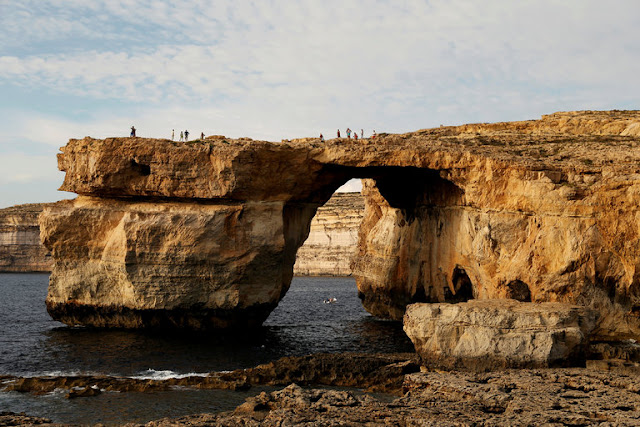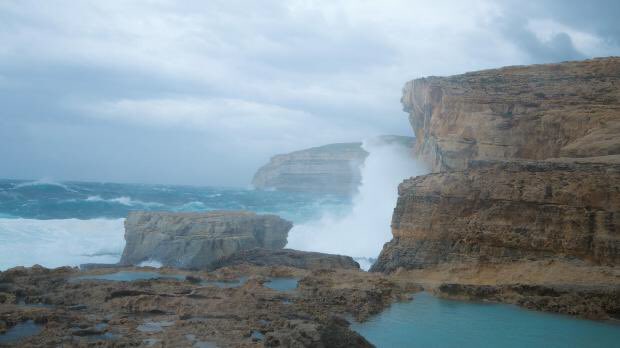Malta’s Azure Window collapses into the sea
 |
| The Azure Window was featured in several films |
Malta’s Azure Window, as seen on ‘Game of Thrones,’ collapses into sea
The limestone arch stood stately against a cloudless sky, towering in the background as Khal Drogo and Daenerys Targaryen wed (and dozens died) in the “Game of Thrones” series premiere. The violent wedding may have been a fictional feature of Essos, but the stone formation was anything but.
Called the Azure Window or Tieqa tad-Dwejra, the natural landmark jutted sharply off the 25-square-mile island of Gozo, one of the three forming the Maltese archipelago in the Mediterranean. Travelers have long sought a view of the striking structure, particularly since its existence has always been fleeting.
The Azure Window has finally closed. During a strong storm on Wednesday morning, it collapsed and fell into the Mediterranean Sea.
“There was a big raging sea beneath the window,” Xagħra resident Roger Chessell, who witnessed the collapse, told the Times of Malta. “Suddenly, the arch collapsed into the sea with a loud whoomph, throwing up a huge spray. By the time the spray had faded, the stack had gone too.”
Calling it “heartbreaking,” Malta Prime Minister Joseph Muscat wrote on Twitter, “I have just been informed that the beautiful Tieqa tad-Dwejra in Gozo has collapsed. … Reports commissioned over the years indicated that this landmark would be hard hit by unavoidable natural corrosion.”
“That sad day arrived,” he concluded.
“Today Gozo has lost one of its iconic beauties,” the Gozo Tourism Association wrote on Facebook. “The inevitable and the much feared has happened. The flagship of the Gozitan touristic sites has sunk in its same birth place. … The much promoted Azure Window is no more, and only millions of photographs remain as testimony of this touristic spot.”
Scientists believe the 92-foot-tall arch, one of 26 in the Maltese Islands, formed as the pounding of sea and rain water eroded the limestone below. Eventually, it grew into the tourist destination it is today. The Gozo Tourism Association estimated that 80 percent of the island’s guests visited the arch. According to a report from the European Commission, that comes out to about 850,000 visitors each year.
In 1998, it was included on a tentative list of UNESCO world heritage sites, though it didn’t progress further.
Eventually, it became a popular filming location, particularly for mythological epics.
In addition to “Game of Thrones,” it was featured in “Clash of the Titans,” NBC’s “The Odyssey,” and the 2002 version of “The Count of Monte Cristo.” It found its way onto the world’s iPhones as well, becoming something of a social media star. Nearly 50,000 Instagram images are tagged with #azurewindow. Countless more were geotagged there.
But it’s always been at risk from nature. In 2013, the Times of Malta published a story with the foreshadowing headline, “The Azure Window is still safe … for now.”
The arch was comprised of two layers of different types of limestone, as explained by Geoscience Consulting head geologist Peter Gatt. The top layer was upper coralline limestone, which is hard-wearing, not too susceptible to erosion. The other layer was blue clay limestone, which is much softer. In 2013, Gatt’s firm issued a report stating, “About 90% of the lower layer of rock has collapsed in the past 30 years.”
Most of this weakening was caused by the very erosion that created the arch, Gatt told the Times of Malta. “Waves crashing against the cliff formed the striking window and they will also destroy it,” he said.
 |
| Photo: Jonnie Atha |
At the time, though, he was hopeful.
“It is safe to say that the Azure Window is not facing any imminent collapse as was previously believed,” Gatt said. “This still doesn’t mean it will last forever — this is a process.”
Last January, though, a large slab of the arch was lost to sea, battered by rough waves.
It didn’t help matters that tourists regularly scrambled across it for photographs and striking views of the Mediterranean Sea. The European Commission report stated that human activity was causing such accelerated erosion that “Drastic action was essential to save this loved feature by the locals.”
Last month, the Maltese government instituted $ 2,300 fines for anyone caught climbing on the arch. But by that point it was too late. All it would take was one strong storm to send the structure back to the sea — and that storm arrived Wednesday.